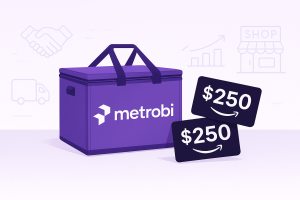Are you under the impression that the success of a traditional restaurant hinges on age-old formulas? It’s time to reconsider. The culinary landscape is transforming, and ghost restaurants are emerging as the unexpected frontrunners in the restaurant industry.
However, success isn’t merely about preparing food in an out-of-sight commercial kitchen, be it a dark kitchen or a cloud kitchen. It involves navigating a complex environment where the victors grasp the dynamics of the online delivery market—and crucially, know when to defy conventional wisdom. Unlike traditional restaurants, these virtual restaurants function without dining rooms or walk-in customers, depending entirely on food delivery services and third-party delivery apps like Uber Eats.
Catering delivery without commissions
Keep more of your revenue by avoiding third-party delivery fees. Learn how Metrobi can help Caterers save on delivery costs.
The real challenge is this: While identifying a thriving ghost kitchen is straightforward, very few restaurant owners can successfully implement their methods within the competitive realm of the restaurant business online.
So, what’s the secret sauce that allows certain virtual kitchens, sometimes managing multiple brands from the same kitchen, to generate substantial profits, while others struggle to stay afloat in their kitchen space? Prepare to be enlightened. This guide goes beyond the basics of the ghost kitchen concept.
We will delve into the core mechanics of these delivery operations, revealing how you can seize opportunities, cut operational costs, and tap into new markets. Discover proven strategies and exclusive tactics that only the most astute players in the restaurant business utilize, including harnessing customer data and cultivating a robust strong online presence. Additionally, as you navigate the complexities of your ghost kitchen operations, ensuring compliance with local regulations is crucial. Understanding how to obtain a food handlers permit will help you avoid common pitfalls that could lead to fines and interruptions in your service. For essential information on this topic, check out our guide on how to secure a food handlers permit.
From building a compelling digital identity to refining those crucial virtual dining interactions and offering great food prepared with high quality ingredients, we’ll address every critical aspect. It’s worth noting that many restaurants, including chain restaurants and even those with an existing restaurant’s kitchen, are actively exploring this innovative model.
And if you’re interested in the trajectory of this evolving delivery business, we have insights on that as well. We’ll highlight how a ghost kitchen operator can achieve remarkable success. We’ll explore emerging trends—from repurposing shipping containers into functional kitchens to effectively leveraging third party apps—and underscore sustainable practices that are not mere marketing ploys but essential drivers of success. These transformations are even influencing traditional brick and mortar restaurants.
If you overlook this invaluable knowledge, you risk being outpaced by competitors in the realms of online ordering and food delivery. Are you prepared to elevate your ghost restaurant concept with strategies that are not only proven and effective but also tailored for 2025? This includes mastering the use of third party delivery and various delivery platforms.
Let’s embark on this journey, examining how even established traditional brick and mortar establishments can reap benefits, enhance their dine in traffic, and gain valuable insights from the customer experience provided by leading virtual brands.
Metrobi drivers are rated 4.97/5
Trusted by local businesses for:
- Background-checked professionals
- Specialized in business deliveries
- Same drivers for consistency
- 4.97/5 average delivery rating
Are Ghost Restaurants Profitable in 2025?
Many ghost restaurants are making money in 2025.
Profit depends on smart operations and marketing.
Success often involves blending delivery with other services.
Current Profitability Landscape
Is starting a ghost kitchen profitable in 2025? In short, it can be. Ghost kitchens benefit from lower costs than traditional setups. There’s no need to pay for dining space or seating staff. But, profits depend on more than just cutting costs. Restaurants must manage operations well, and launch effective marketing. Menus should suit delivery and locations should be strategic.
Industry Growth Rate: The ghost kitchen industry is projected to grow at a CAGR of 7.6% by 2027, reaching a total market volume of $466.2 billion.
Success isn’t always easy. A ghost kitchen might not do well if it relies only on delivery. According to Meredith Sandland, traditional dining settings account for the majority of a restaurant’s income. Because of this, many profitable ghost kitchens have started to use hybrid or omnichannel methods, combining multiple sales techniques to bring in more orders and profit. Before launching your ghost kitchen, it’s essential to ensure that you’re compliant with local regulations concerning food safety. A crucial aspect of this is obtaining a proper food handling certification, which can prevent potential fines and ensure the safety of your food products. Understanding the nuances of a food handlers permit is vital to your success in this industry. Learn more about the necessary requirements by checking out our guidelines on food handling permits.
US Market Expansion: In 2025, food delivery revenue in the U.S. is projected to reach $42 billion, up from $33 billion in 2022.
Examples of Successful Ghost Restaurants
Several brands stand out as successful in this space. MrBeast Burger made a big splash. This shows the power of a strong, already-known brand. Krispy Rice and It’s Just Wings are also examples of ghost kitchens doing well. These brands have managed to balance costs, effective marketing, and product appeal.
US Business Growth: The number of ghost kitchen businesses in the U.S. was 7,594 in 2023, reflecting a 2.3% increase from 2022.
Expert Insights on Chain Restaurants 2025 Profitability Trends
What do industry experts say? They expect some important shifts that might affect success. There is a trend moving towards omnichannel models. Atul Sood highlights the importance of allowing customers to pick up their orders. This not only provides convenience but can also boost sales.
Operational excellence is another key focus. Zhong Xu emphasizes the need for ghost restaurants to excel in their processes to be profitable. Efficient operations can lower costs and increase profits. Established brands are leveraging their already-known names. As James Walker states, known brands can deliver their products effectively using ghost kitchens.
The role of tech and analytics is growing. Companies like CloudKitchens help kitchens use data to improve their operations. This tech can help ghost kitchens find ways to make each part of their process better and more profitable.
Ghost restaurants that adapt to these trends are more likely to be successful by 2025. They need to expand their income beyond deliveries and focus on running their operations really well.
Step-by-Step: How to Make a Ghost Kitchen Successful
Building a strong virtual brand is fundamental
Enhancing online dining experiences boosts customer satisfaction
Strategic menu planning increases profitability
Step 1: Setting Up Your Virtual Brand
Creating a strong brand is crucial in the bustling digital marketplace of ghost kitchens. It’s what helps you stand out from the crowd. A well-thought-out brand can make the difference between being noticed or overlooked. Start by defining your brand’s unique selling points. What makes it different from countless others? Your brand must tell a compelling story. “The key to success in ghost kitchens is having a strong, differentiated brand that stands out in a crowded digital marketplace. Your brand needs to tell a compelling story that resonates with customers scrolling through delivery apps.” Think about your target audience and what they value.
Step 2: Optimizing Virtual Dining Experiences
Customer experience online is just as vital as in a physical restaurant. A user-friendly online ordering system can be the make-or-break factor for attracting customers. The process should be seamless, intuitive, and quick. Focus on simplicity and efficiency in user design.
Using feedback from your customers is an ongoing process for improving these experiences. Encourage reviews and comments. This valuable input can provide insights into what works and what needs refinement. Enhancing digital interactions also includes swift follow-ups with users to resolve concerns or to thank them for their patronage.
Step 3: Food Quality Menu Strategies for 2025
In today’s competitive landscape, menu differentiation is vital. It distinguishes your ghost kitchen in a sea of other options. Craft a menu that highlights unique offerings, all while aligning with modern customer preferences. Ensure the dishes travel well, maintaining quality upon delivery.
Menu pricing plays a significant role in maximizing profits. It’s essential to strike a balance between cost efficiency and a price point that captures the market. Use data and consumer trends to fine-tune your options. “Menu engineering is critical for ghost kitchen profitability. Focus on items that travel well, have good margins, and are in high demand. Use data to constantly refine your menu.” Adjust your menu according to what’s trending to stay relevant.
Additional Steps for Success
Leverage Technology: Incorporate modern tech like AI for inventory management and to analyze sales data.
Multi-Brand Strategy: Consider operating multiple brands from a single kitchen to optimize resources and appeal to varied tastes.
Promotion: Use digital marketing strategies to promote your virtual brand through social media, SEO, and partnerships with delivery apps.
Adaptation and Testing: Make use of the flexibility offered by ghost kitchens to test new concepts and adapt quickly. This agility is an asset. “Ghost kitchens allow for rapid experimentation. Use this to your advantage by testing new concepts, menu items, and pricing strategies. The brands that iterate fastest will win.”
By crafting a strong virtual brand, optimizing customer experiences, and implementing strategic menu plans, ghost kitchens can achieve success in 2025 and beyond. Now equipped with these actionable steps, you’re ready to thrive.
Emerging Ghost Kitchen Trends to Watch
New tech in ghost kitchens boosts efficiency
Eco-friendly practices answer growing consumer demand
These shifts impact profits and business models
Trend 1: Technological Integration
In the past year, ghost kitchens have embraced technology like never before. Many have integrated systems such as AI-driven demand forecasting. This provides precise predictions of customer demand, allowing kitchens to adjust inventory and staffing. Robotic food prep is another tech advancement. It streamlines processes and reduces labor costs.
Meredith Sandland notes, “Ghost kitchens are embracing technology to streamline operations, from AI-powered demand forecasting to robotic food preparation. This allows them to operate more efficiently and scale quickly. These innovations aren’t just about cutting costs. They’re about running operations in a smart, scalable way.
Throughout 2024, we saw a consistent trend of tech adoption. AI improvements helped kitchens optimize supply chains. kitchens were using customer data to refine their menus. This data-centric approach is emphasized by Michael Schaefer, “The most successful ghost kitchens are leveraging data analytics to optimize every aspect of their business.” As these technologies become more available, more ghost kitchens will adopt them to gain a competitive edge. The fast pace of tech integration shows no sign of slowing down.
To choose the right tech, understand your needs. Decide if you aim to cut costs, enhance speed, or improve customer satisfaction. Look for solutions that integrate with existing systems. Ensure they are scalable to your business size.
Trend 2: Sustainable Practices
Eco-friendly operations have become key in ghost kitchens. Over the last year, there’s been a clear shift to sustainable methods. Many kitchens started using eco-friendly packaging and energy-efficient equipment. reducing food waste became a priority. This change was driven by rising consumer demand for sustainability. As Aaron Noveshen mentioned, “Sustainability is becoming a key focus for ghost kitchens. Consumers increasingly expect this, so it’s both an ethical and business imperative.”
The push for sustainability began gaining real traction. A noticeable number of operators implemented sustainable practices. This move not only helped the environment but also attracted eco-conscious diners. consumer trends showed an increase in preference for sustainable options. Businesses that adopted these practices saw improved brand loyalty and customer engagement.
For ghost kitchens looking to adopt sustainable practices, start small. Focus on eco-friendly packaging. Consider energy-efficient appliances and spotlight them in your marketing. Emphasize sustainability efforts in communications with customers. This is not just good for the earth; it’s increasingly crucial for attracting modern consumers.
Emerging trends like technological integration and sustainability are defining ghost kitchens. This evolving landscape presents growth opportunities. Looking ahead, these trends will continue to shape how businesses operate. Technology will become even more advanced and prevalent. Sustainability will become a basic expectation. For operators, staying ahead requires ongoing adaptation. Embrace changes early to capitalize on the advantages they offer.
What Is the Success Rate of a Ghost Kitchen?
Understand what makes a ghost kitchen successful.
Learn about key metrics to track ghost kitchen performance.
Explore how tech boosts success in ghost restaurants.
Understanding Success Metrics Using Data Analytics
Success in ghost kitchens depends on several performance indicators. Key factors include profit margins, customer retention, and order accuracy. Each of these plays a role in overall success. To gauge customer satisfaction, measuring retention rates is essential. High retention suggests a loyal customer base, while low retention flags issues with service or product quality.
For tools, businesses can use customer feedback platforms to measure satisfaction. Tracking apps help monitor delivery times and order accuracy. Analytics can spotlight trends and areas needing improvement. Consistent tracking ensures adjustments can be made swiftly, keeping performance in check.
Adapting Delivery Platforms Technology
Technology enhances ghost kitchen success. Its role is crucial in boosting efficiency and customer satisfaction. Automation in operations provides faster service. It improves order processing, reducing human errors. Additionally, AI can predict customer demand, optimizing ingredient ordering and reducing waste.
Examples highlight its impact. A kitchen that automates workflows sees a boost in operational efficiency. This translates to faster, more reliable service for customers. Embracing technology often requires initial investment but pays off by streamlining processes and enhancing the bottom line. Successful adoption depends on choosing the right solutions tailored to specific needs.
How Do Ghost Restaurants Work in a Commercial Kitchen?
Ghost restaurants operate differently from traditional restaurants. They focus solely on delivery, bypassing the need for a storefront. This model allows for flexibility in location, often setting up in areas with lower rent. Despite no dine-in option, choosing a strategic location for quick delivery access remains vital.
Projected Drive-Thru and Takeaway Market Share: Ghost kitchens are projected to capture a 50% market share of the drive-thru and takeaway foodservice markets by 2030.
Staffing in ghost kitchens is lean, focusing on cooks and delivery coordination. Unlike traditional eateries with servers and greeters, ghost kitchens streamline operations behind the scenes. This efficiency reduces costs, allowing more focus on kitchen tasks and food quality.
The business model also differs in other ways. Traditional restaurants earn from dining experience, while ghost kitchens rely on online engagement and marketing. Success in ghost kitchens demands sharp logistical planning and top-tier efficiency. This ensures that food reaches customers promptly, keeping them satisfied and coming back for more.
“Ghost kitchens were kind of a victim of their own success. The pandemic gave the business model a false positive.” This reflects some of the challenges ghost kitchens faced as they adapted from an explosion of demand, underscoring the importance of strategic planning and sustainability in success.
Frequently Asked Questions (FAQ)
How does a ghost kitchen concept differ from a traditional brick-and-mortar restaurant?
A ghost kitchen, unlike a traditional brick-and-mortar restaurant, operates solely for delivery and takeout without a dining area or customer-facing storefront. This reduces overhead costs like rent, front-of-house staffing, and décor. Brick-and-mortar restaurants rely on foot traffic and the dine-in experience, while ghost kitchens focus entirely on online ordering and efficient delivery. A ghost kitchen can also operate multiple virtual brands from a single kitchen, maximizing resource utilization in a way a traditional restaurant cannot.
Five-Year Growth Rate: Over the past five years (2018–2023), the number of ghost kitchen businesses in the U.S. has grown at an average annual rate of 2.3%.
How is the food industry adapting to the rise of ghost kitchens?
The food industry is adapting to the rise of ghost kitchens by embracing new technologies and business models. Traditional restaurants are increasingly incorporating ghost kitchen elements, such as dedicated delivery-only menus or separate kitchen spaces for online orders.
Food delivery platforms are partnering with ghost kitchens to expand their offerings. Suppliers are adapting to the unique needs of ghost kitchens, such as providing bulk ingredients and packaging optimized for delivery. The entire industry is shifting towards a more digital, delivery-focused approach, driven by consumer demand and the efficiency of the ghost kitchen model.
What is the core business model of a successful ghost kitchen?
The core business model of a successful ghost kitchen revolves around operational efficiency, a strong online presence, and a focus on delivery. It leverages technology to streamline ordering, food preparation, and delivery processes. Successful ghost kitchens often operate multiple virtual brands from a single kitchen to maximize resource utilization and cater to diverse customer preferences.
They prioritize creating a compelling online brand, optimizing their menu for delivery, and building strong relationships with delivery platforms. Data analysis plays a crucial role in understanding customer preferences, optimizing pricing, and managing inventory.
Can an existing brick-and-mortar restaurant benefit from incorporating a ghost kitchen concept?
Yes, an existing brick-and-mortar restaurant can significantly benefit from incorporating a ghost kitchen concept. It allows them to expand their reach and revenue streams without the significant investment of opening a new physical location. They can use their existing kitchen space and staff to fulfill delivery-only orders, either under their existing brand or by creating new virtual brands. This can help them reach new customers, test new menu concepts, and optimize their operations for the growing delivery market, ultimately increasing overall profitability and resilience.
Conclusion
When we look back at the key strategies that drive profitable ghost restaurants, it becomes evident that success in this dynamic field depends on innovation and adapting. By 2025, thriving ghost kitchens, whether they operate from a dedicated physical location or utilize an existing restaurant’s kitchen, are those that effectively leverage compelling virtual brands, exceptional customer experiences, and thoughtfully curated menu selections.
These crucial elements elevate a mere operation that simply needs to prepare food into a flourishing restaurant business. It is clear that most virtual restaurants recognize the inherent challenge of lacking foot traffic and actively work to overcome this limitation.
We’ve explored the intricacies of establishing successful virtual brands, enhancing digital dining interactions through delivery apps, and optimizing menu strategies—all while minimizing operating costs. Emerging trends, such as technological integration and sustainable practices, present promising avenues for future profitability.
This even extends to brick-and-mortar establishments aiming to broaden their market reach. The optimistic profitability outlook shared by industry experts highlights a bright future for those who are prepared to embrace change and navigate the absence of front-of-house staff.
Moving forward, it’s crucial to recognize that sustained success hinges on continuous evaluation and refinement. Key performance indicators (KPIs) and customer feedback are indispensable tools. Technology, especially sophisticated delivery service management, plays a pivotal role, in guiding ghost kitchens towards enhanced efficiency and increased success rates.
Now, equipped with valuable insights and actionable strategies, you are well-prepared to confidently enter the realm of ghost restaurants. Put your newfound knowledge into practice and witness the remarkable transformation. Your next venture in the restaurant industry is on the horizon. Are you poised to revolutionize the restaurant experience and establish a lasting presence, even without a traditional brick-and-mortar establishment, by capitalizing on the power of food delivery and the strategic utilization of delivery drivers?













